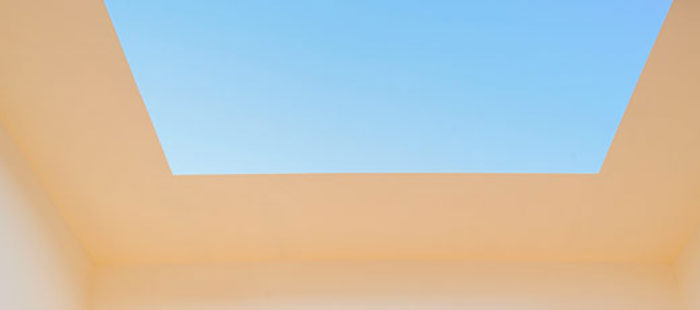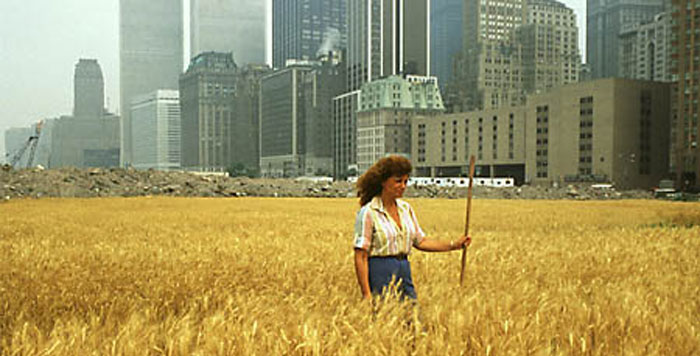This is the first of six posts about the present. Caveat lector.

Networks are invisible landscapes, shoals, and seabeds. Things flow over them, they admit different frequencies, they refract and channel, but they are strata of the same world.
I went to see James Turrell’s Meeting at MoMA’s PS1 in Queens. There’s a door in one of the corridors of this old school, just like all the other doors, but when you enter, you realise a hole has been cut in the roof, framing the sky. Magical, peaceful — and on the day I visited, a bright, bright blue, with fluffy white clouds. Light fills the room. Everybody smiles.
I have a strong recollection of Peter Zumthor’s Serpentine Pavilion, but the white walls, the height of the ceiling, its place, so unexpectedly, within a building, all make it more secular and cathedral-like at the same time. Zumthor’s spaces always have a sense of ritual to them, an arcana, a hidden meaning. They are made from burned materials, worked-over, used. Entering the pavilion involved a doorway, a passage, and a threshold; his memorial to the witches involves a similar transition, a bridge or pier that must be traversed to access the sacred space. Turrell’s space does away with this; it is open in every sense: welcoming, clear, whole, available, unthreatening, sublime, transcendental.
I want to return in different seasons and at different times of day, just as I encounter manifestations of my changing self in the network. The reminder UI, Timehop, Recollect: the endless return to the self.
I saw Storm Thorgerson give a talk in London last year. He was live-art-directing an album cover, and it was funny, because every Storm Thorgerson cover is essentially the same thing: something soft, or human, or strange, in a hard landscape. It’s about the sense of scale and wonder that’s intrinsic to that juxtaposition. But you need to see the landscape.

Richard Long’s walks that inscribe a line in the earth, and that’s the work. A trace of the human in the landscape, something that endures, measured against and inevitably, appreciatively reclaimed by the environment.

Agnes Denes’ Wheatfield in Lower Manhattan, a brief, vital image against the skyscrapers of the financial district, against the World Trade Center. Grown on the spoilheaps of an expanding city. The field of wheat is the ultimate image of nature, but a man-made nature, a nature intrinsic to civilisation. Not a new nature: the same nature we’ve had all along, that isn’t separate from us, that is interleaved with us and our civilisation and our lives, a constant presence we grow out of and measure ourselves against and make accommodations with and admire and disturb.
Land Art reconceptualises the world itself, which we have not yet been able to do to the network. Land Art prefigures the artworks of the network, inextricably linking itself to its environment, built out of the same materials, anti-commercial and avant-garde.
I keep thinking we need a Land Art for the Web. Land Art was such a short moment, an alteruniverse when a certain social and critical change exploded out of the galleries and was rapidly reappropriated, its wonders circumscribed. And Isamu Noguchi’s playgrounds never got built.
Rob Holmes‘ conception of the US Corps of Engineers as Land Artists (cf the Dredge Research Collaborative). Perhaps Timehop and Recollect and Flickr archives and Instagram and Twitter are the land art of the internet: contrasting us against the landscape of the network, which is memory.
The ideas around the New Aesthetic grew in part out of a dissatisfaction with the cultural dominance of retro and vintage. I’ve spent plenty of time articulating the cognitive dissonances of electronic books: this is what is happening to everything. The cognitive dissonance of time, what some people have called atemporality, which appears as hauntology, and which I sometimes prefer to think of as simultaneity or network realism. Atemporality is not an aesthetic, its the affect of this condition.
Everything constructed, building towards this point. Everything undermined, ready to pull it all down as soon as the moment is upon us. Like those old Quaker meeting houses with the single point, the central pin, which when removed would collapse the house and thus remove the grounds for prosecution under unlawful assembly acts. Or the business of setting up meeting houses at a crossroad, so the congregation could call from window to window, hold a service in common without violating the same laws.
Turrell’s “Meeting” was inspired by the meeting houses of Quakers: their plain benches around the walls, the congregation facing one another. That feeling you get in there, it’s like vertigo, the sublime of the network, produced by the transfigurated encounter with ourselves.
Comments are closed. Feel free to email if you have something to say, or leave a trackback from your own site.